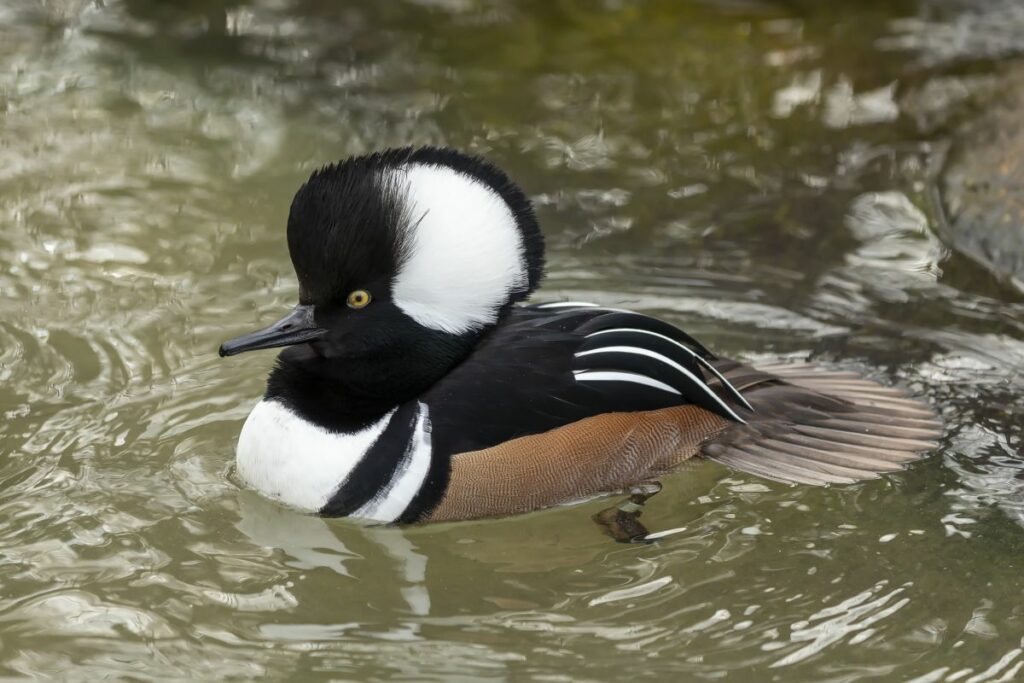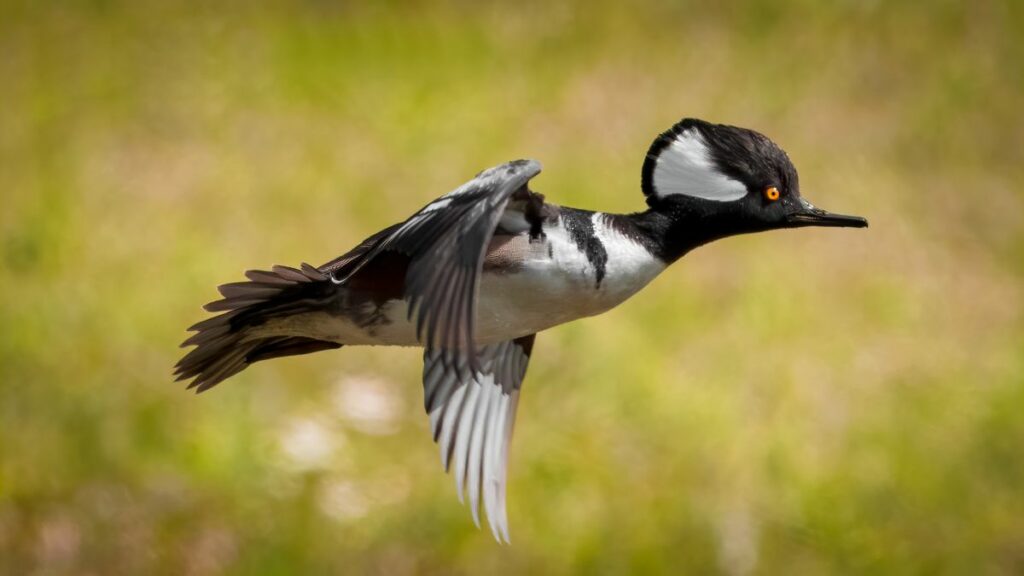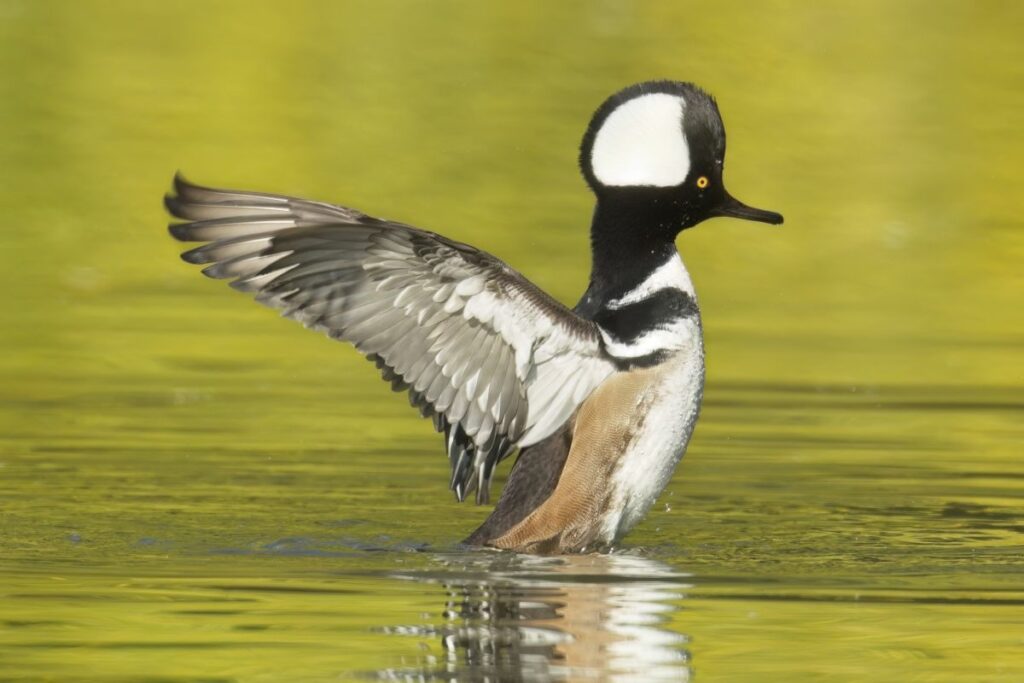The hooded merganser is a unique duck breed that has a fan-shaped crest on its head to make it look bigger. If you live in North America, there’s a chance you might’ve seen these ducks swimming in bodies of water.
Hooded Merganser Duck Overview

Before we look at the details of this unique duck species, here’s an overview of its traits.
| Location | North America |
| Lifespan | 11 to 13 years |
| Weight | 1.2 to 1.5 pounds |
| Length | 16 to 19 inches |
| Appearance | Brown, black, and white feathers with large head crest |
| Egg Production | 5-13 eggs per year |
| Can Be Kept in Captivity? | No |
What are Hooded Mergansers?
Hooded Mergansers are a wild species of diving duck. Diving ducks are one of the main types of ducks, and they refer to ducks that regularly submerge themselves in water to collect food. This is different than dabbling ducks, who only take food from the water’s surface.
These unique-looking ducks are common in their range, and the large crest on their heads help them stand out from similar species. They’re often described as “a duck with a mohawk.”
Hooded Merganser Population
The hooded merganser population is stable. Their conservation status is listed as “least concern.” Their population has shown a slight increase since 1966, so their wild population isn’t currently threatened.
Can Hooded Mergansers Be Kept in Captivity?
It’s possible to keep a hooded merganser in certain places if you have a permit, but it’s not recommended. They’re wild animals that won’t provide much benefit to your farm. So, unless you own a zoo or animal sanctuary, you likely won’t be able to keep them in captivity.
One reason most wild ducks don’t make good pets or livestock is because they need to migrate in the winter. Many duck species have instincts that aren’t suitable for captivity, especially with an inexperienced owner. They also don’t lay eggs regularly like domesticated ducks do.
Hooded Merganser Duck History

Hooded Mergansers were first described by Carl Linnaeus in 1758, along with many other bird species. Their scientific name is Lophodytes cucullatus, and they’ve always lived across North America. There may be a small population of these birds in Europe because some escaped captivity.
Habitat
These birds are native to North America. They’re mostly found across the United States and southern Canada. They’re most common in forests near the Great Lakes. You’ll almost always see these birds near bodies of water since that’s where their food sources come from.
They migrate short distances in the winter, moving to areas of the United States where the water doesn’t freeze over. They prefer freshwater, but they’ve been located near brackish water before.
Appearance
Hooded mergansers are unique birds because they’re the shape of a typical duck, but they each have a large crest on their head, making their head look bigger and rounder than it actually is. Their fan-shaped crests are collapsible.
These ducks are on the smaller size, and they have thin beaks that are ideal for catching prey while diving. When they fly, you’ll notice that their wings are thin and rounded. Their legs are located far back on their bodies to assist with diving.
Coloring
The males usually have light brown feathers on their body, black wings, and a white chest. Their heads are mostly black, but the center of the crest is white, which is most noticeable when the feathers are standing upright. They have amber eyes.
Even though the females are shaped similarly, their feather colors are duller. They’re usually a mix of brown and gray, but they still have a fluffy crest.
Size and Shape
Hooded mergansers are usually 1.2 to 1.5 pounds, and they’re 16 to 19 inches long. Their wingspan is 23 to 26 inches. They can be described as the size of a crow.
Diet
Like other diving ducks, hooded mergansers mainly feed by diving below the water’s surface and fully submerging their bodies. By doing so, they can catch small fish, crustaceans, and aquatic insects. They may also eat tadpoles, mollusks, and plant materials. Young hooded mergansers only eat insects.
These ducks may grab food off the shore or water’s surface if they have to, but their feet and beaks aren’t built for that type of foraging. So, diving is their primary hunting method.
Hooded Merganser Behaviors

Hooded mergansers socialize with other birds of their species, but they may display aggressive or territorial behaviors at times.
Socializing
These ducks are almost always seen with birds of the same species. Sometimes, they can be seen in pairs, but other times, they hang out in groups of up to 40 birds.
Movements
You’ll almost always see these birds floating in the water. The way their legs are positioned makes walking on land awkward but it allows them to dive beneath the surface with ease. They need the water to be at least 18 inches deep for them to thrive, so keep that in mind if you own a sanctuary or aviary where these ducks are kept.
When it’s time to take flight, these ducks run along the water before taking off. They fly using fast wingbeats, and they only glide if they’re about to land.
Crest Movements
These ducks can use their crests to communicate with each other. When males raise their crests, lots of white feathers show, so it’s a way to attract attention to themselves. Males may raise their crests as a way to attract females or scare off threatening males.
Breeding
To court a female, hooded mergansers show off their beautiful crests. Females are attracted to the birds with the biggest crests and the whitest feathers. So, males with small crests may never reproduce.
Several males approach a female at a time during the mating season. The males may move their heads around to show off their crests. They make a frog-like croak while displaying their feathers.
If a female in interested in a male, she will bob her head at him and make a hoarse sound in return. Once the female lays the fertilized eggs and begins incubating them, the male leaves her. She then has to raise the eggs and ducklings herself. It’s unknown if the females ever reunite with their mating partners again.
Hooded Merganser Egg Production
Most hooded mergansers lay about 5 to 13 eggs in one clutch. However, researchers have found up to 44 eggs in a nest at a time. These birds only lay one brood each year. Their eggs are white and almost spherical.
So, these ducks aren’t raised for eggs like domesticated birds are. Domestic ducks and chickens regularly lay infertile eggs year-round while most wild duck species only lay eggs during their breeding season. These ducks usually breed between February and June.
Frequently Asked Questions

Here are some lingering questions you may have about this duck breed.
There are plenty of duck breeds that are bred to be kept as livestock. Here are a few domesticated duck breeds:
American Pekin
Indian Runner Duck
Muscovy
Crested Duck
Saxony Duck
Call Duck
Rouen Duck
Hooded mergansers live 11 to 12 years in the wild. If kept in captivity, they may be able to live an extra year or two.
Yes, many duck hunters target hooded mergansers. They’re usually hunted as a trophy item rather than for meat. Those looking to hunt ducks must follow the hunting laws in their area.
Finding a Duck Breed for You
If you’re looking to become a duck keeper, you may be fascinated in all duck species. However, not all types of ducks are ideal for keeping in captivity.
Hooded merganser ducks are one of the many wild duck species that feed by diving below the surface. They don’t do well in captivity because they need access to deep water and they need to migrate.
So, if you’re trying to decide what the right type of duck for you is, start by looking at domesticated duck breeds. There are many that do great when kept at a farm.
